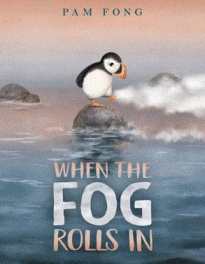
When The Fog Rolls In
When The Fog Rolls In
Pam Fong
Greenwillow, 2024
32pp., hbk., RRP $A24.99
9780063136540
On a clear day, when the sea and the horizon stretch endlessly around, the flock of puffins takes flight from their rocky island home – except for one, who is a little tentative and anxious. But, when he has the courage to follow his mates, the fog rolls in and things become murkier and murkier until it is so thick, he stumbles and can’t find his way forward. Perhaps it would be safer to stay just where he is, but when a walrus looms in front of him, he realises that that can be dangerous. And so, he summons his brave that let him leave his home in the first place, and goes forward learning that “the closer you get, the more you see. And the more you see, the clearer the path becomes.” And eventually, the fog lifts and the world and the horizons spread in front of you again.
On the surface this is a story about a little puffin separated from his flack, lost, afraid and bewildered until he finds them again, but it has been deliberately written as an allegory for helping young ones navigate uncertainty, open their minds and finding their way back to a place of safety and certainty. It helps them understand that, at times, we all face feeling lost and unsure, having to make decisions and having faith that what we decide will lead us to clarity.
While there are lots of stories that celebrate being happy and positive, and others that deal with anger and sadness, there are few that confront confusion and uneasiness in such a way that makes it easy to start conversations and explore those emotions so that the child not only understands that there can be a pathway through without becoming too anxious, but others feel the same way at times.
An exceptional addition to your mindfulness collection for little ones, while useful for teaching older students about allegories and learning to read between and beyond the lines to what the author is really saying – an essential skill in being a critical reader.